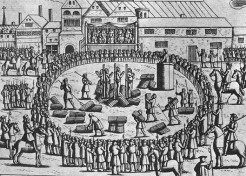A literary reference fifteen years in the making
/In 1997 I took an English class that featured the writing of Anne Askew, a sixteenth century English poet who was persecuted as a heretic. She is the only woman on record to have been tortured in the Tower of London before being burnt at the stake. The class was quite difficult. The text was written in Old English, and it was not easy reading by any stretch of the imagination.
I often found myself wondering why the hell we were reading it at all.
Almost fifteen years later, I have now run into the first Anne Askew reference since my college days. My current book club novel, The Tower, The Zoo and the Tortoise, by Jane Stuart, references Askew’s torture at the Tower of London (the setting for the book).
A literary reference fifteen years in the making. Was it worth the effort of that class and the long wait?
Maybe.
There’s a definite joy that one derives in acknowledging a reference that few others might understand or even notice.
A thousand times more powerful than the satisfaction of an inside joke.
And it also gave me reason to research the details of Askew’s execution, which were horrific but interesting nonetheless:
Askew was burnt at Smithfield, London, at the age of 25, on July, 16 1546, with John Lascelles and two other Protestants. She was carried to the execution in a chair as she could not walk (having been tortured for information prior to the death sentence).
She was dragged from the chair to the stake which had a small seat attached to it, which she sat astride. The executioner hung a bag of gunpowder around her neck as a humane act in order to speed her death along, and it exploded nearly immediately. Those who saw her execution were impressed by her bravery, and reported that she did not scream until the flames reached her chest.
This execution took place 450 years ago, and I still felt a pit in my stomach when reading about the details of this young woman’s death.
